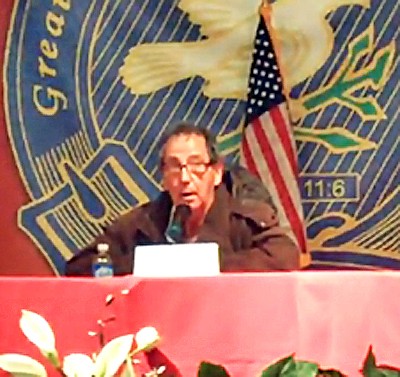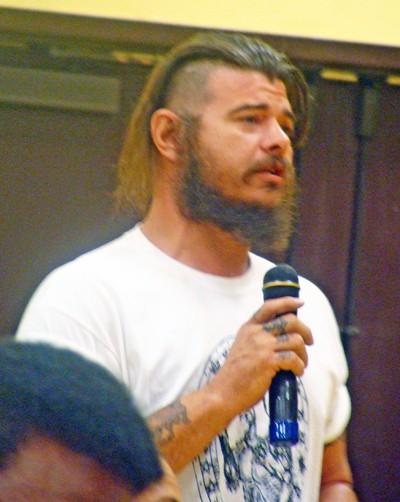As the first installment of the election season heads toward the home stretch, with early voting for the May 4th county primaries beginning this week, the public is being treated to some flamboyant circumstances — and it’s a moot question as to whether and how much they bear on the issues.
Some matters seem open and shut. As is customary in any election year, there have by now been numerous candidate forums for various offices — some of them well attended, some not. The most unusual of them so far was probably that held by the Institute for Success Center of Greater Faith Tabernacle on Shelby Drive last week for county mayoral candidates.
 JB
JB
Lunati (no ‘c’) on the go.
The mayoral forum was the third in a sequence held by the center for candidates seeking various offices. All were conscientiously organized around the traditional formula of round-robin questions for various candidates, with some questions posed by local high school students and others solicited from the audience.
The nature of such proceedings is that, particularly in races where the candidates have had adequate time to develop their basic responses and reiterate them over and over, things have a tendency to gravitate toward the wonky.
That’s especially true when the questioners opt, as they do and should do, for the serious of purpose and seek the candidates’ attitudes toward chestnut issues like consolidation. The resultant answers, at this point of the campaign, are as well prepared, and perhaps as unavailing, as were the trenches and embedded firing stations of World War I.
Enter Ernest Lunati, the onetime felon (he served time on pornography charges) who materializes these days mainly as a perennial candidate in races he has no chance of winning. This time around, Lunati is the nominal opposition to Sheriff Mark Luttrell for the Republican nomination for Shelby County mayor.
Fringe candidates like Lunati are the bane of the come-one, come-all public forum. They are understood to have no chance of prevailing, and, indeed, they have no visible network of supporters, but somehow they scrounge up 25 signatures of certified voters on their petitions, and, voilà, candidates they are.
The epitome of this breed is Robert “Prince Mongo” Hodges, who has been running pointlessly (in every sense of the word) for decades, but, for reasons unknown, has not favored the electorate with his presence this time around. In recent years, Lunati has begun to crowd Hodges’ act, and for the last year or two, there has been yet another candidate of the extra-terrestrial sort — Leo Awgowhat, whose adopted name is literally a variation on the format of the knock-knock joke.
 JB
JB
Awgowhat on the move
Apparently, Awgowhat, who was on the ballot for Memphis mayor last year and is an independent candidate for county mayor this year, did not make timely application to appear in last week’s Institute for Success Center forum or, as a non-primary candidate, was ineligible.
In any case, he was there in the Greater Faith Tabernacle sanctuary, and he made his presence felt twice — once by yelling out, “And you lied!” when interim mayor Joe Ford was accounting for his change of mind about running for a full term as mayor, another time by attempting, unsuccessfully, to pose an antagonistic ad hominem question aimed at both Ford and Luttrell.
So it was largely up to Lunati to hold the fort for the utterly unorthodox. And he delivered — managing to respond to conventional political questioning with the most outré non sequiturs imaginable — at one point implying that the other candidates present (GOP opponent Luttrell and Democrats Ford and Otis Jackson) might be crack addicts and calling for them to be drug-tested, at another point suggesting that juvenile crime could best be curbed if girls having their hair pulled in the classroom would “snitch” by calling 911.
(For those interested, two of Lunati’s more eccentric answers are available in video form at “Political Beat” on the Flyer website.)
The moral of the story? None really, except that the usual plethora at election time of fringe and token candidates makes it difficult to stage truly inclusive forums (ask anyone who has ever attempted to organize one) and that (let’s admit it) the comic relief they provide can actually be a welcome break from the robotic repetitions of mainline candidates and even, once in a while, truly stimulating.
• The aforementioned mayoral candidate, Otis Jackson, who is now serving as General Sessions Court clerk, got a scare last week but one which, ironically, resulted in his getting a pass this week.
Commissioner Mike Ritz, something of a self-appointed fiscal watchdog on the county legislative body, pressed a relentless interrogation of Jackson last week, on the basis that the latest county audit had revealed the clerk’s books to have been seriously “unreconciled.” That word, and its variants, got a serious workout during a committee hearing which revealed mismatching account entries dating back several years.
In the end, it was decided that several of the problems were attributable to a dysfunctional computer system installed under the previous clerk, Chris Turner, who was defeated by Jackson in 2008. But the most serious shortcoming involved a matter of some $3 million directly traceable to Jackson’s administration that remained (that word again) “unreconciled.”
Jackson was not under suspicion of malfeasance, but, still, the discrepancy in his books, coupled with Ritz’s previous accusations that the clerk had spent prodigally on dining occasions for his staffers, threatened to put his mayoral campaign (already of the dark-horse variety) in crisis mode.
Two things occurred to, er, reconcile Jackson’s situation. One, he was able to submit a supplemental report adjudged by the county auditing team to have properly resolved the discrepancies. Two, in the meantime interim county commissioner John Pellicciotti, who was appointed last year to fill a vacancy in District 4, Position 3, levied a motion to censure three clerks — Jackson, Chancery Court clerk Dewun Settle, and Probate Court clerk Chris Thomas — for what county audits and “management letters” had revealed to be persistent problems in reconciling their books.
Inasmuch as Thomas is now a candidate for the commission’s District 4, Position 1 seat — the same seat being sought by Pellicciotti, who is switching tracks because he had promised, upon his appointment, not to seek reelection for the Position 3 seat — his colleagues were sufficiently diffident as not to offer him a second.
But his motion, with all its potential political volatility, returned to the full commission’s regular public meeting, and, when Commissioner J.W. Gibson, who hadn’t been at last week’s committee hearing, seconded the motion, Pellicciotti was given a platform to make his point against Thomas. Clerk Settle had meanwhile been excused from blame, and Jackson, too, having already undergone his ordeal, was now off the hook — at the behest of Ritz, no less, who, perhaps seeing a dilemma that cut both ways, partisan-wise, professed a desire to “get [it] behind us and move on.”
Thomas, speaking to the commission in his defense, offered an apology “that my opponent is doing this to y’all” and observed that, as several commissioners already had, “this is political.” He pointed out that he had corrected the indicated fault — a failure to resolve his ledger precisely on a monthly, as against an annual, basis — and lamented, “This is exactly why … y’all don’t want to appoint someone to fill out a term that says they are not going to run, and then they run.”
(He would pass out copies of his own charge — that Pellicciotti should return the county funds that paid for the interim commissioner’s recent public hearings on consolidation, on grounds that Pellicciotti had used the occasions for his own campaigning, something Pellicciotti would staunchly deny.)
In the end, votes were held on the Jackson and Thomas matters. Jackson was exonerated by a 13-0 vote, with Pellicciotti himself concurring, and Thomas, too, saw his censure charge defeated. That one went 12-0, with Pellicciotti recusing himself.
On the surface, then, it appeared that Thomas was victorious, but Pellicciotti, who probably entered the race as an underdog, got a bully pulpit to display himself as a self-declared and single-handed reformer. Speaking to reporters later on, he would condemn an “old boys’ network” that “the people who have been there too long are tied into.”
He went on, “Nobody is willing to call each other out. We have got to hold these people responsible. … We [meaning himself] will continue to hold people accountable. We will not put up with people not managing the people’s money appropriately. We are past the time of just ‘trusting’ politicians.”
And, finally: “We’ve got to get rid of these guys who have been in office forever.” [Thomas had boasted of his 16 prior years of service as clerk.]
“We need young people who can tell us that’s not right.”

 JB
JB  JB
JB